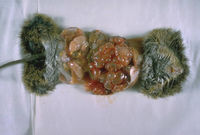Difference between revisions of "Echinococcus multilocularis"
| Line 23: | Line 23: | ||
|} | |} | ||
| − | [[Image:Rat infected with E. multilocularis.jpg|thumb|right| | + | [[Image:Rat infected with E. multilocularis.jpg|thumb|right|200px|Rat infected with ''E. multilocularis'' - Dr. I. Kagan]] |
==Overview== | ==Overview== | ||
Revision as of 17:36, 26 July 2010
| This article is still under construction. |
| Echinococcus multilocularis | |
|---|---|
| Kingdom | Animalia |
| Phylum | Platyhelminthes |
| Class | Cestoda |
| Sub-class | Eucestoda |
| Order | Cyclophyllidea |
| Family | Taeniidae |
| Genus | Echinococcus |
| Species | E. multilocularis |
| Also known as: | Dwarf fox tapeworm |
| Causative agent of: | Alveolar Hydatid Disaese |
Overview
E. multilocularis is not present in the UK but is endemic in central Europe and North America. It is zoonotic and so presents a major health problem in Europe (including Switzerland where urabn foxes are now infected) haveing spread from 4 countries in the 1980s to being found in 12 countries now. This has been attributed to the anti-rabies campaign which has increased the number of foxes which are commonly found as the definitive host. Humans can act as intermediate hosts if eggs are ingested causing the formation of hydatid cysts in the liver, these rapidly invade the liver and are inoperable.
Characteristics
Scolex
- 2 rows of hooks
Proglottid
- Terminal proglottid forms 1/2 the length of the mature worm
- 1 proglotted shed per week
- Has single genital pore
Eggs
- Striated shell
- Hooks visible on oncosphere
Life Cylce
E. multliocularis has a typical cestode life cycle involving the formation of a metacestode cyst in the intermediate host before developing to adulthood in the definitive host. The definitive host for E. multliocularis is most commonly the dog, though it has also been seen in the cat. Epedimiologically the most important definitive host in the spread of the disease is the fox. E. multliocularis mainly uses small rodents such as voles, mice and rats as an intermediate host, forming multilobular hydatis cysts in the liver of the host. The sahort life span of the intermediate host species is the reason for the rapid growth of the cyst, even in longer lived host like humans. This is the stage that generally causes pathology in the host animal and can be fatal.
